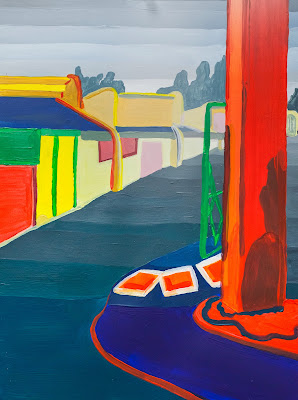make a selection from more flat, solid, graphic artwork with a defined color amount that you can seperate and reproduce by mixing and matching that color palette.
you must consider the dominant areas and less dominant colors when you do your sketches. make a list of colors, measure out the color proportions on the 3"x 9" strip with ruler of course (straight lines) and figure out the larger areas, medium, smaller color areas. You will have to determine approximate visual percentages when breaking down the colors of your chosen piece of artwork. (10-15 chosen colors on your palette strip).
Design FOUR Sketches (showing color distribution and proportions) creating and mapping out a well balanced, creative abstract composition. Analyze and start applying colored areas in your sketches as a visual reference. use color pencils, watercolor etc on your drafts in your sketchbook. figure out the division of your color strip.
Materials
• Bristol board, 9x12"
• reference painting (from art books in closet)
• 9"x3" bristol strip for swatch of colors
• All 3 pieces to be (Reference Painting, color swatch palette, Final Composition)
Process
Find several pages from art magazines, art reproductions, Paintings with color combinations that you usually don't use. You are going to create a proportional color inventory, Meaning, taking a careful visual inventory of the colors used in the painting and mixing each color to match the original color and measure out on the swatch strip the dominant colors, less dominant and least dominant colors. Examine, analyze and map out the colors as well as thinking of your composition. you will create four sketches of ideas for composition. be very aware of the larger areas (break it up if you need) and smaller areas and you need use your imagination for color placement, separate them if you think it's to heavy in one area. again. check hierarchy, composition, color relations, ID the colors and where they will be placed for painting.
PROPORTIONAL INVENTORY
Make a proportional inventory with countable number of tones (select more graphic artwork or paintings where you can visually seperate different hues of the painting, or (textiles, woodcuts, or silkscreen prints are good sources.)
Create a color palette (about 9" X 3") that matches colors and estimates proportions. Design a composition of your own using the colors and proportions of the inventory.

Students' samples


Comp B NON-PROPORTIONAL INVENTORY
Make a non-proportional inventory with uncountable number of tones (images taken from the natural world are good sources).
This is different from Proportional inventory because the source images has so many colors and tones you must summerize the main colors that really create the essence of the piece of artwork you chose.
Begin the inventory with a square of flat color, (about 5 X 5 inches) use a background color directly from the image. Try to match the colors you observe precisely (the best you can), create between ten and 15 different dots. Design a composition of your own using tones drawn from the non-proportional inventory.

Students' samples




















